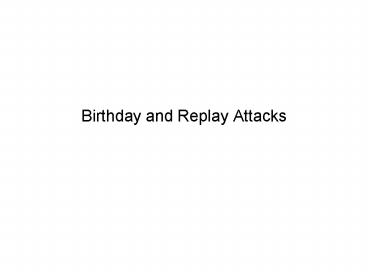Birthday and Replay Attacks PowerPoint PPT Presentation
1 / 20
Title: Birthday and Replay Attacks
1
Birthday and Replay Attacks
2
From Schneier
Attacks
- One-way functions can be used for message
signatures/authenticators. Note The one-way
function will be many-to-one - Matching a specific signature with a randomly
generated message requires at worst 2b attempts
where b is the number of bits in a signature - Example choose one person of a group of 23, the
probability that another person from the group
will have the same birthday as this person is 1-
(364/365)22 ? 0.06 (Low)
3
From Schneier
Birthday Attack
- Problem birthday attack on signature if it is
easy to find two random messages that map to the
same signature then a birthday attack is easy - Example the probability of 2 people having the
same birthday in a group of 23 people is more
than 0.5 - Difference from previous did not pick a specific
persons birthday to match
4
From RSA FAQ
Birthday Attack - description
- Suppose there is a high enough probability that
- of k randomly chosen messages at least two will
map to the same authenticator - (i.e. finding two messages that map to the same
authenticator is easy). - The attacker selects two messages
- one he wants to get sent,
- one the sender is likely to sign.
5
From RSA FAQ
Birthday Attack - description
- The attacker then
- generates k innocent-looking variations of each
of the two messages - till he finds one from each set that map to the
same authenticator. - Of these two, he gets the sender to sign the one
she is more likely to sign.
6
From Stinson
Birthday Attack - Implications for size of
message digest
The number of random attempts for a birthday
attack is of the order of ?n where n is the
number of total messages n 2b where b is the
number of bits in an authenticator or digest.
Hence, signatures should be of length at least
128
7
Cryptographic Hash Functions
- SHA Secure Hash Algorithm
- RIPEM
- MD4
- MD5
- MD6
- Etc.
8
Applications of Public Key Encryption and
One-way Functions Digital Signatures
9
Public key and digital signatures
- Encrypt Digest(x) instead of x
- Signature Creation by sender S
- x ? Digest(x) ? y ePrivate(Digest(x))
10
Public key and digital signatures
- Signature Verification
- Given (X, Y) sent by sender S, check that X was
indeed sent by S and has not been changed along
the way - dPublic(Y) ? Digest(X)
- If not equal
- Digest(X) is incorrect, i.e. message was not X OR
- dPublic is incorrect, i.e. Sender is not S
11
Digital Signature Standard (DSS)(Memons slides)
- Adopted as standard in 1994
- We do not study DSS in this course.
12
Digital Signatures signing and verification
- Digital Signatures Signing.
- Alice signs m to get
- Sprivate(A)(m) Eprivate(A)(h(m))
- She then encrypts with Bobs public key to get
- Epublic(B)m Sprivate(A)(m).
13
Signature Verification
- Bob decrypts with private key to get
- Dprivate(B)Epublic(B)m a m a
- Bob then verifies Alices signature with her
public key to get - Dpublic(A)a ? h(m)
- It should match, as it would if a
Sprivate(A)(m)
14
Replay attack
- The message can be repeatedly sent and does not
need to be resigned. - Give Oscar 1000 on my behalf. I will pay you
back - - Alice.
- Ways of avoiding.
15
Avoiding Replay(from Memon notes)
16
Proof of Knowledge (POK)
- If a user can prove she holds a number (usually a
key) without revealing it, she has provided a
proof of knowledge (of the number) - Usually used to demonstrate one holds a private
key
17
Session Key Exchange With KDC - 1
- A -gt KDC IDA IDB N1
- (Hello, I am Alice, I want to talk to Bob,
I need a session Key and here is a random nonce
identifying this request) - KDC -gt A E KA( K IDB N1 E KB(K
IDA) ) - Encrypted(Here is a key, for you to talk to
Bob as per your request N1 and also an envelope
to Bob containing the same key) - A -gt B E KB(K IDA) (Alice does not know
E KB) - (I would like to talk using key in envelope
sent by KDC)
18
Protocol II contd. Session Key Exchange With
KDC - 2
- B -gt A E K(N2)
- (OK Alice, But can you prove to me that you
are indeed Alice and know the key?) - A -gt A E K(f(N2))
- (Sure I can!)
- Last two steps - challenge-response. Commonly
used to thwart replay attack. - Why f? Why random N2?
19
Protocol IIProtection against replay attacks
- Random N2 provides Bob with protection against
somebody who knows the encrypted value of a
single fixed N2 - f provides Alice with protection from someone who
is trying a known-plaintext attack, making her
encrypt EK(N2)
20
References
- Bruce Schneier, Applied Cryptography
- Douglas Stinson, Cryptography Theory and Practice
- Dominic Welsh, Cryptography and Codes
- RSA FAQ http//www.rsasecurity.com/rsalabs/faq/

